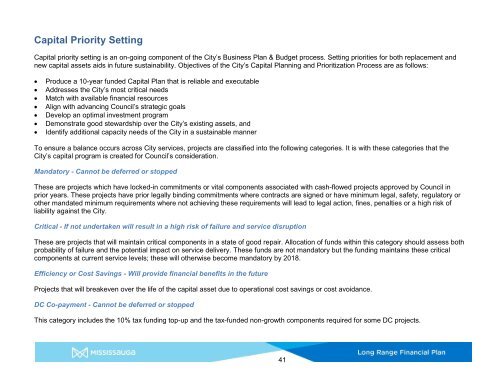Long Range Financial Plan
You also want an ePaper? Increase the reach of your titles
YUMPU automatically turns print PDFs into web optimized ePapers that Google loves.
Capital Priority Setting<br />
Capital priority setting is an on-going component of the City’s Business <strong>Plan</strong> & Budget process. Setting priorities for both replacement and<br />
new capital assets aids in future sustainability. Objectives of the City’s Capital <strong>Plan</strong>ning and Prioritization Process are as follows:<br />
<br />
<br />
<br />
<br />
<br />
<br />
<br />
Produce a 10-year funded Capital <strong>Plan</strong> that is reliable and executable<br />
Addresses the City’s most critical needs<br />
Match with available financial resources<br />
Align with advancing Council’s strategic goals<br />
Develop an optimal investment program<br />
Demonstrate good stewardship over the City’s existing assets, and<br />
Identify additional capacity needs of the City in a sustainable manner<br />
To ensure a balance occurs across City services, projects are classified into the following categories. It is with these categories that the<br />
City’s capital program is created for Council’s consideration.<br />
Mandatory - Cannot be deferred or stopped<br />
These are projects which have locked-in commitments or vital components associated with cash-flowed projects approved by Council in<br />
prior years. These projects have prior legally binding commitments where contracts are signed or have minimum legal, safety, regulatory or<br />
other mandated minimum requirements where not achieving these requirements will lead to legal action, fines, penalties or a high risk of<br />
liability against the City.<br />
Critical - If not undertaken will result in a high risk of failure and service disruption<br />
These are projects that will maintain critical components in a state of good repair. Allocation of funds within this category should assess both<br />
probability of failure and the potential impact on service delivery. These funds are not mandatory but the funding maintains these critical<br />
components at current service levels; these will otherwise become mandatory by 2018.<br />
Efficiency or Cost Savings - Will provide financial benefits in the future<br />
Projects that will breakeven over the life of the capital asset due to operational cost savings or cost avoidance.<br />
DC Co-payment - Cannot be deferred or stopped<br />
This category includes the 10% tax funding top-up and the tax-funded non-growth components required for some DC projects.<br />
41







